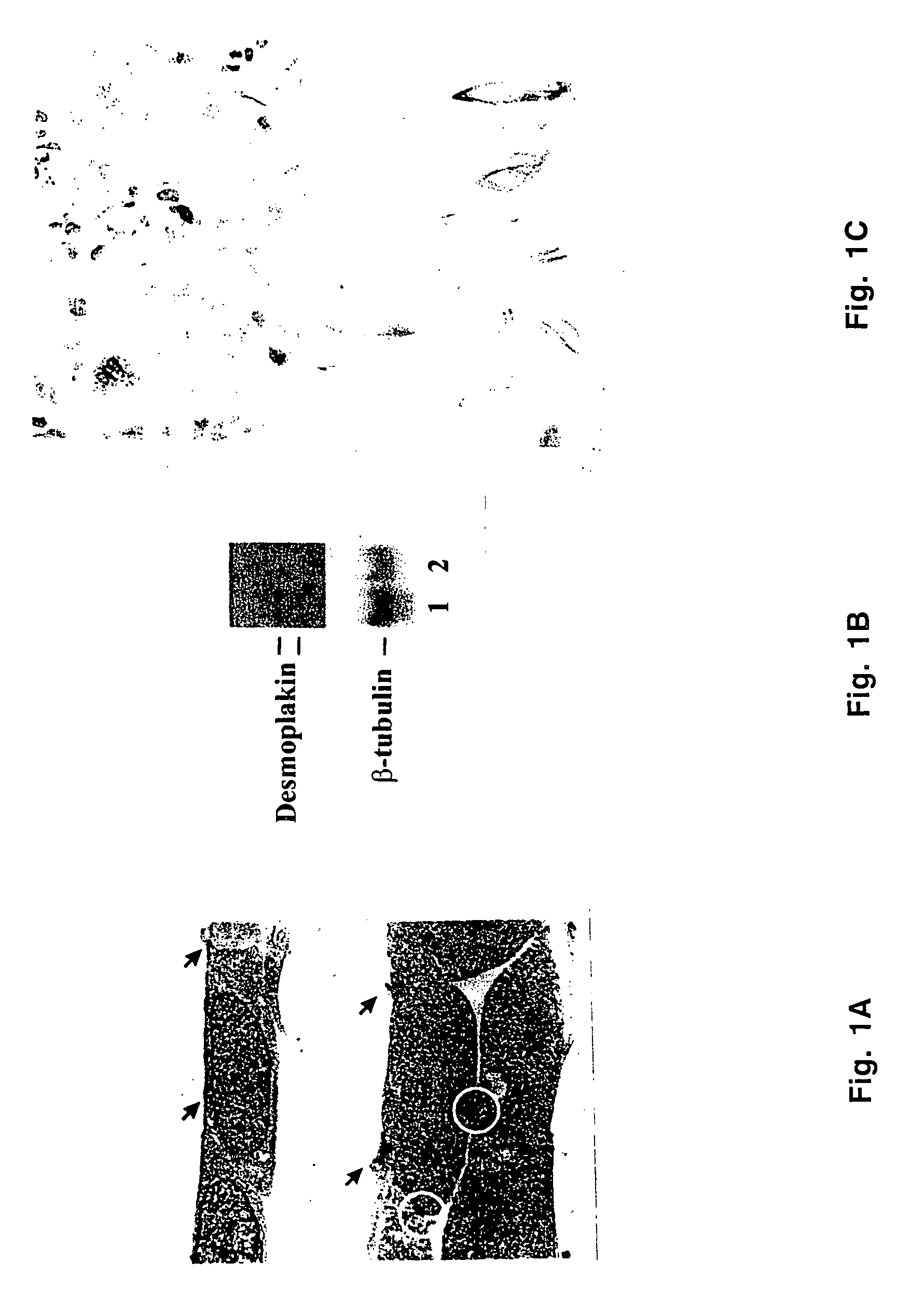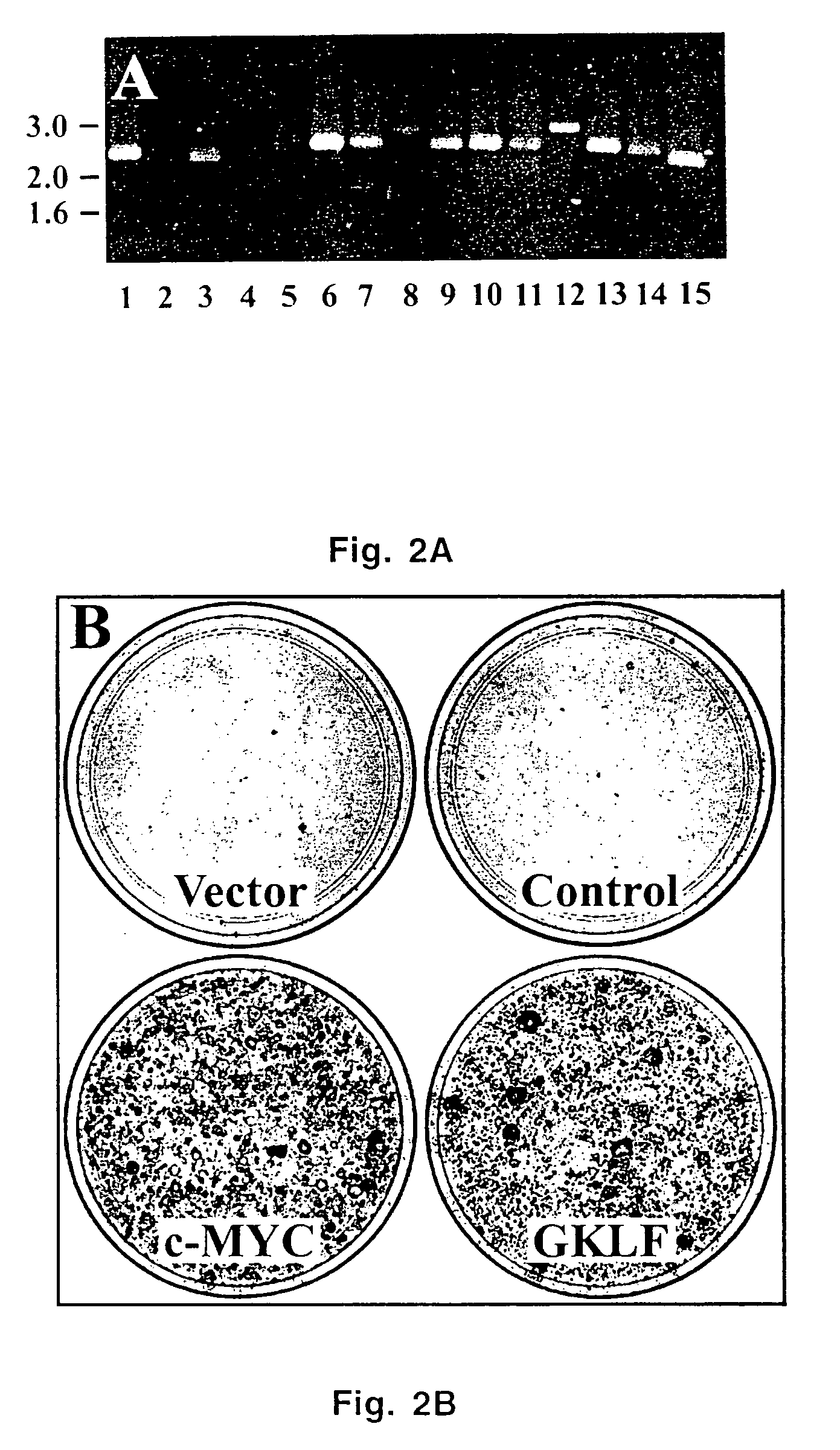Krüppel-like transcriptional factor KLF4/GKLF and uses thereof
a transcription factor and kruppel-like technology, applied in the field of molecular oncology, can solve the problems of insufficient methods of identifying carcinoma, inability to perform in vitro assays for functional expression cloning, etc., and achieve the effect of increasing the risk of recurrence or death
- Summary
- Abstract
- Description
- Claims
- Application Information
AI Technical Summary
Benefits of technology
Problems solved by technology
Method used
Image
Examples
example 1
cDNA Libraries Construction
[0056]To identify transforming genes, mRNA from human squamous cell carcinoma- or breast tumor-derived cell lines was used. These tumor types do not exhibit frequent alteration of RAS or GLI. Two cDNA libraries were constructed using the ZAP-Express™ cDNA synthesis kit (Stratagene, La Jolla, Calif.). A library was prepared from human squamous cell carcinoma cells derived from tumors of the oro-pharynx. Equal quantities of total mRNA from cell lines SCC15, SCC25, and FaDu (ATCC, Rockville, Md.) were pooled. Similarly, equal quantities of mRNA from the breast cancer cell lines MCF-7, ZR75-1, MDAMB-453, and T47D (ATCC) were pooled. For each pool, poly A+ mRNA was selected by two cycles of oligo-dT cellulose affinity chromatography. Five μg was reverse transcribed using an oligo-dT linker primer and MMLV reverse transcriptase. Double-stranded cDNA was synthesized using E. coli RNAase H and DNA polymerase I. cDNA was ligated to λZAP EXPRESS™ bacteriophage arms ...
example 2
RK3E Cells have Characteristics of Epithelia
[0063]RK3E cells are a clone of primary rat kidney cells immortalized by transfection with adenovirus E1A in vitro (Ruppert et al., 1991). The cells exhibit morphological and molecular features that are epithelioid. They are contact-inhibited at confluence and are polarized with apical and basolateral surfaces and electron-dense intercellular junctions typical of adherens junctions and desmosomes (FIG. 1A). Northern blot analysis showed that RK3E cells, but not REF52 fibroblasts, expressed desmoplakin, a major component of desmosomes and an epithelial marker (FIG. 1B).
[0064]By immunocytochemical staining, the mesenchymal marker vimentin was low or undetectable in RK3E cells but was strongly positive in REF52 cells (FIG. 1C). Neither line reacted strongly with anti-cytokeratin or anti-desmin antibodies. Antibodies to vimentin and desmin were from Dako (Carpenteria, Calif.). A cocktail of anti-cytokeratin included AE1 / AE3 (Biogenics, San Ram...
example 3
Isolation of c-MYC And GKLF / KFL4 by Expression Cloning
[0066]The libraries were cloned into the MMLV retroviral expression plasmid pCTV1B (Whitehead et al., 1995), packaged in BOSC23 cells, and high-titer virus supernatants were applied to RK3E cells as described above. Fourteen foci, identified at 10-20 days post-transduction, were individually expanded into cell lines. Thirteen of these contained a single stably integrated cDNA, as indicated by PCR (FIG. 2A). Eleven of these were identified as human c-MYC by end-sequencing and restriction enzyme analysis. The c-MYC cDNA in lane 15 included the coding region and 193 bases of 5′ UTR sequence (Accession V00568). As determined by sequencing or restriction mapping, the other c-MYC cDNAs extended further 5′ (lanes 1,3,5-7,9-11,13-14), such that all of the clones contained the entire protein-coding region.
[0067]In addition, two cell lines (FIG. 2A, lanes 8 and 12) contained cDNAs coding for GKLF / KFL4. Mouse and human GKLF / KFL4 cDNAs were ...
PUM
| Property | Measurement | Unit |
|---|---|---|
| diameter | aaaaa | aaaaa |
| concentration | aaaaa | aaaaa |
| pH | aaaaa | aaaaa |
Abstract
Description
Claims
Application Information
 Login to View More
Login to View More - R&D
- Intellectual Property
- Life Sciences
- Materials
- Tech Scout
- Unparalleled Data Quality
- Higher Quality Content
- 60% Fewer Hallucinations
Browse by: Latest US Patents, China's latest patents, Technical Efficacy Thesaurus, Application Domain, Technology Topic, Popular Technical Reports.
© 2025 PatSnap. All rights reserved.Legal|Privacy policy|Modern Slavery Act Transparency Statement|Sitemap|About US| Contact US: help@patsnap.com



